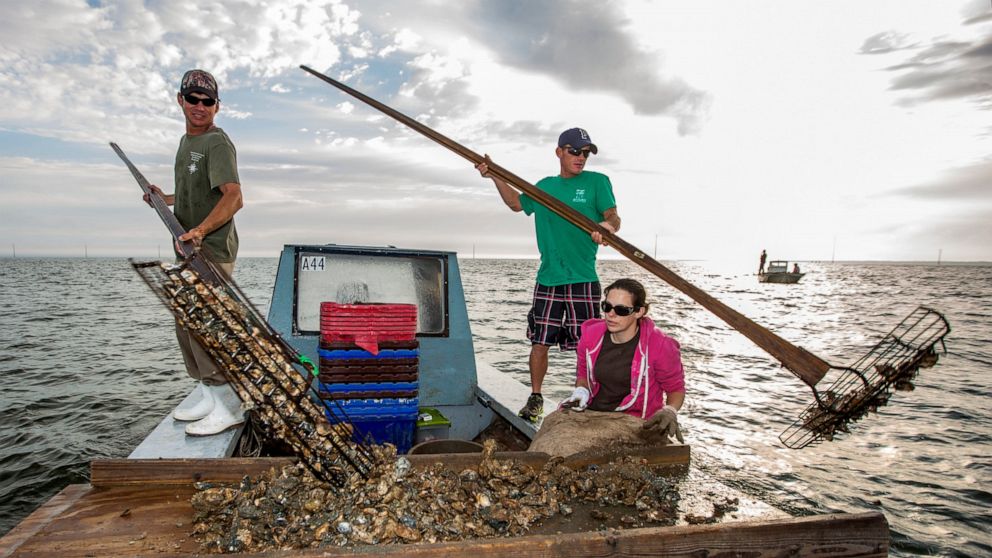Florida might shut down bay known nationally for its oysters
A Florida agency is expected to shut down oyster harvesting in Apalachicola Bay through the end of 2025 on Wednesday
TALLAHASSEE, Fla. — Because of a dwindling oyster population, a Florida agency is expected to shut down oyster harvesting in Apalachicola Bay through the end of 2025, dealing a blow to an area that historically produced 90% of the state’s oysters and 10% of the nation’s.
The Florida Fish and Wildlife Conservation Commission is scheduled to vote on the closure Wednesday during a virtual meeting. People in the area are divided between coming up with a long-term plan to save the industry, and allowing it to continue on a limited basis.
“It breaks my heart, man. I’ve watched boats out there my whole life,” said Brandon Martina, who works at Lynn’s Quality Oysters, a bayfront business his family has run since 1971. The business started out as a wholesale oyster-shucking house, but as supplies dwindled, they converted it into a retail seafood shop and restaurant.
But instead of serving Apalachicola oysters, they’re buying them from Texas.
“We went from running tractor-trailer loads to getting maybe eight to 10 bags a day, so we just started doing a hatch shell bar,” he said.
The commission issued an emergency order in July shutting down oyster harvesting on Aug. 1 until it considers the five-year shutdown at Wednesday’s meeting. The industry has struggled for years, in large part due to a drain on freshwater flowing into the bay. Atlanta uses the water upstream as a water supply, and as it has drawn more water, it’s affected the salinity level in the bay that helps oysters thrive.
David Barber owns a wholesale and retail oyster and seafood business in nearby Eastpoint. He’s one of less than a handful of wholesalers in a region that used to have dozens, but now he’s selling Texas oysters.
Still, he thinks a five-year closure is going too far, saying the right conditions could help oyster populations spring back quickly.
“They should listen to the people who work the bay, especially some older guys,” Barber said. “I don’t think nobody in the county is against them closing it for a little while to let them repopulate … If it takes five years, that’s another thing, but they can do it year by year.”
The sweet, salty, plump mollusks are prized well beyond the region, and tourists have flocked to tiny, lost-in-time Apalachicola — population 2,354 and known to locals as Apalach — to enjoy water views at restaurants that served raw, shucked oysters pulled out of the bay that morning.
The once-booming oyster industry is part of the lifeblood of Apalachicola, a town that has had to reinvent itself over the past two centuries. In the 1830s as the cotton industry grew, the town became the third-largest port on the Gulf of Mexico, trailing only New Orleans and Mobile, Alabama.
Cotton made Apalachicola wealthy, but after the Civil War it turned to a new source of wealth: lumber. When lumber faded, it reinvented itself again and prospered on shrimping and oyster harvesting.
As the seafood industry took a hit, Apalachicola turned to tourism and is now known for it’s 19th- and early 20th-century buildings, quaint independent shops, restaurants, bars and easy-going pace.
Still, the oyster industry provides jobs, leaving many to have to look elsewhere for work. For decades, Apalachicola by far led the state in oyster production, but the decline began about three decades ago and the industry nearly collapsed in 2012.
Shannon Hartsfield used to work the waters, but gave it up eight years ago because of shrinking oyster supplies. He now works with university researchers studying the bay and efforts to help it recover.
“It doesn’t need to reopen until it can sustain 100, 150 families instead of just three or four,” Hartsfield said, recalling the days when the industry was booming. “Shoot, all the way down down beach there were oyster houses, and right now there’s only one. David Barber is the only one that’s even got a shucking house in Eastpoint, and there’s only two in Apalach. That’s crazy. Between Apalach and Eastpoint there were probably over 60 processing plants.”
![]()


